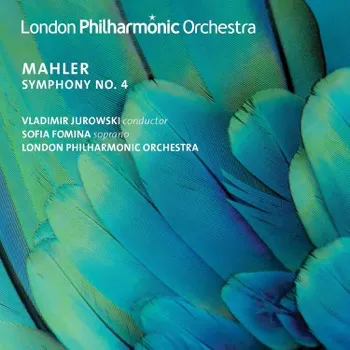This is Vladimir Jurowski’s third Mahler recording with the London Philharmonic Orchestra, after recording the first two Symphonies with the group. No word if this is going to be a full cycle, but based on this current release of the Fourth Symphony, many will be eager for some more.

As in the previous albums, the strings of the London Philharmonic shine through the entire performance, but in this new album the woodwind, brass and percussions seem to be much more incorporated into the mix. The subtle accompaniments and solos are superfluous here, such as the clarinet’s high notes and the horn’s long phrases in the first movement, or the flute in the slow third movement, strengthening the warm strings. The second movement is particularly fine, with leader Pieter Schoeman gives a characteristic account of the “fiddler” role, depicting (according to Alma Mahler at least), a call from the dead.
The transitions in the long movements are perhaps the most difficult to pull off, and in this case they are most impressive. The first movement is a good example; Listen to the acceleration at 1:45 and the transition to the second subject, or to the highly effective fermata at 11:22, which return to a care-free mood right after. These transitions are not only effective due to tempi, though, as can be heard in the basses and woodwind guidance to the return of the main theme at 4:00. Generally speaking, Jurowski and the orchestra are well immersed in this Symphony’s internal conflicts of child-like naiveté with cynical serious-mindedness.
This is a live recording, taken from the notoriously dry acoustics of London’s Royal Festival Hall. Yet the acoustic has its upsides – the Pizzicati in the second movement have never sounded so pointed, added by a nicely executed performance by the woodwind sections. The only downside here is that the climaxes, especially in the first movement, lacks the bloom of other digital performances (some listed below), but an attuned listener will be able to imagine these climaxes communicated, even if not coming through the speakers.
The slow movement is truly wonderful, giving the strings an ample opportunity to show off the uniformity. There is something old-school in this way of playing, in a good sense, a warmth that’s lacking from other digital versions, fine as they are, as by Adam Fischer with the Düsseldorfer Symphoniker or by Eliahu Inbal with the Tokyo Metropolitan Symphony Orchestra.
Jurowski didn’t go to an extreme choice of using a child-singer, as Yoel Levy and Leonard Bernstein did, but his soprano, Sofia Fomina, brings a nice lightness to her role without losing complexity. The quick figurations are playful, contrasting well with the broad segments of this final movement.
Listening to this performance with the score is a delight, seeing how well Jurowski observes Mahler sometimes over-deliberate markings. But this version will appeal to any Mahler enthusiast. Highly recommended.
Mahler – Symphony No. 4
London Philharmonic Orchestra
Vladimir Jurowski – Conductor
LPO, CD LPO0113




















